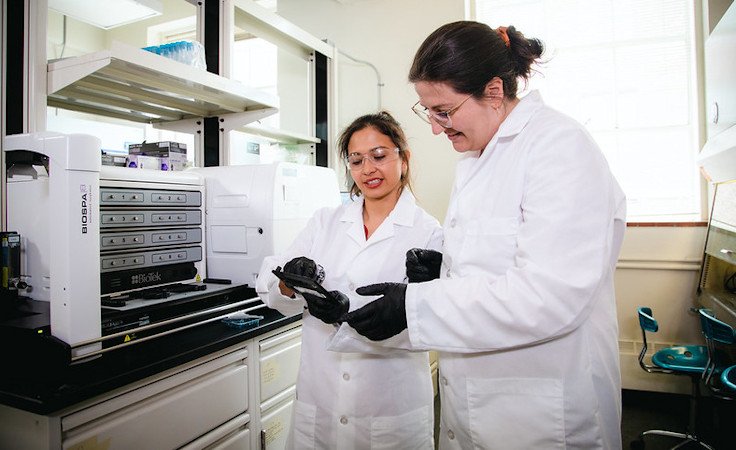OSU researchers develop new model to speed, improve evaluation of cervical cancer drugs

CORVALLIS, Ore. (KTVZ) – Researchers at Oregon State University have created a means of speeding up and improving the evaluation process for drugs used to combat cervical cancer.
The study led by Kaitlin Fogg, assistant professor of biological engineering in the OSU College of Engineering, is important because the American Cancer Society estimates that nearly 14,000 new cervical cancer cases will be diagnosed in the United States this year and that more than 4,000 women will die from the disease.
Findings were published in the Journal of Biomedical Materials Research.
Fogg and graduate students in the College of Engineering worked with the College of Pharmacy High-Throughput Screening Services Lab to develop a model enabling the simultaneous and rapid testing of multiple drug compounds, opening the door to large-scale screenings that can uncover new therapies and personalized medicine options.
A key element of the model is that it uses a three-dimensional cellular platform, which differs from the historic means of testing the effectiveness of anti-cancer drugs: a single layer of cells.
“Two-dimensional monolayer models aren’t able to fully replicate the tumor microenvironment since nothing in our bodies resembles a single layer of cells on a piece of hard plastic,” Fogg said. “Cancer metastasis and the creation of new blood vessels the tumors need are inherently three-dimensional processes and need to move through materials that better resemble the body.”
But many 3D testing techniques don’t match up very well with standard high-throughput screening methods, Fogg said. Three-dimensional testing so far has mainly relied on plates with 24 wells, and 96-well plates are the norm for high-throughput screening. The plates, which hold the samples and compounds to be tested, resemble large-scale ice cube trays.
High-throughput screening, or HTS, is the automated testing of the therapeutic effectiveness potential of large numbers of different molecules simultaneously. It accelerates drug analysis because vast “libraries” of compounds can be screened quickly and cost effectively.
“Our goals were to develop and validate a tumor in a dish model that approximates the cervical cancer tumor microenvironment, interfaces with existing high-throughput methods, and can evaluate cancer invasion and blood vessel formation over time,” Fogg said. “We engineered a multilayer, multicellular model of cervical cancer in a 96-well format that is significantly better than any currently available preclinical drug screening platform.”
The model enables the evaluation of hundreds of drugs at the same time and the rapid identification of those able to thwart cancer invasion and the formation of new blood vessels, she said. That’s important because at present there are no drugs used specifically to treat cervical cancer.
Globally, cervical cancer is the fourth most frequently occurring cancer in women, with about 600,000 new cases diagnosed each year, according to the World Health Organization.
In a majority of cases, various strains of the human papillomavirus, a sexually transmitted infection also known as HPV, play a causal role. The immune system of most women prevents the virus from causing problems, but sometimes the virus survives and contributes to healthy cervical cells becoming cancerous.
Early-stage cervical cancer generally is not accompanied by any symptoms. Signs of more-advanced cases include vaginal bleeding after sex, between periods or after menopause; watery, bloody vaginal discharge that may be heavy and have a foul odor; pelvic pain; and pain during intercourse.
Cervical cancer is most often diagnosed in women ages 35-44 and rarely develops in women younger than 20. More than 20% of cases occur in women over 65, with most of those in women who did not undergo regular screening for cervical cancer.
“I’m excited for the platform we came up with to be used in future studies that screen large compound libraries for drug discovery and precision oncology,” Fogg said. “The platform captures cell behavior in the tumor microenvironment and accounts for patient to patient variability.”
Also taking part in the research were Ines Cadena, Mina Buchanan, Conor Harris, Molly Jenne and Skip Rochefort of the OSU College of Engineering and Dylan Nelson of the Oregon State College of Pharmacy.
The National Institute of Environmental Health Sciences partially funded the study.
About the OSU College of Engineering: The college is a global leader in artificial intelligence, robotics, advanced manufacturing, clean water and energy, materials science, computing, resilient infrastructure and health-related engineering. Among the nation’s largest and most productive engineering programs, the college awards more bachelor’s degrees in computer science than any other institution in the United States. The college ranks second nationally among land grant universities, and third among the nation’s 94 public R1 universities, for percentage of tenured or tenure-track engineering faculty who are women.
